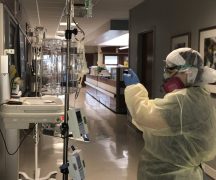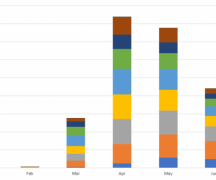First came protests outside the home of then-state health director Dr. Amy Acton.
There were guns, a police presence, anti-vaccine activists, a man in Proud Boys apparel on a motorcycle, and another man wielding an anti-Semitic sign, all cluttering the sidewalks outside Acton’s bucolic suburban home.
Since then, members of “Moms Against DeWine,” some of whom attended the Acton demonstrations, have formed these residential protests at the personal homes of Acton’s replacement, Stephanie McCloud; Senate President Larry Obhof, R-Medina, as he controlled the fate of a bill to defang the Ohio Department of Health; and Gov. Mike DeWine, in defiance of a 10 p.m. curfew he issued to slow the spread of COVID-19.
On Tuesday morning, about 10 members of Moms Against DeWine (MAD) sign-waved and shouted into a megaphone from the sidewalk outside the personal home of Deborah Pryce — a former Republican congresswoman who now serves as chairwoman of the Ohio Liquor Control Commission.
They said they came to protest Pryce, who they characterized as an unelected appointee of “Dictator DeWine” meting out punishments to bars and restaurants accused by the Ohio Investigative Unit of violating social distancing orders.
Judi Phelps, a MAD organizer, carried a pistol holstered around her bright pink snow pants. At least one other demonstrator, Tracy Ann, said she was carrying a concealed weapon.

Two members of the Ohio State Highway Patrol observed the protest from their vehicles. An OSHP spokesman declined to explain why the officers were dispatched.
Pryce did not respond to requests for comment.
The protest Tuesday comes on the heels of a shooting into the home of a senior Ohio Department of Health official.
Just after 8 p.m. Saturday, police say an unknown person in a vehicle fired gunshots into the home of ODH Assistant Medical Director Dr. Mary Kate Francis in Upper Arlington, a wealthy Columbus suburb not known for gun violence.
Upper Arlington Police Department Officer Bryan McKean said Tuesday it’s too early in the investigation to tell if the shooting is related to Francis’ ODH role. He said Francis was not home at the time of the shooting and did not respond when asked whether anyone else was.
Francis, while unknown to most the public, served as ODH’s expert witness on the epidemiology of COVID-19 in quasi-judicial hearings before Pryce and the Liquor Commission. A spokesman with the attorney general’s office said she served in this role on four occasions between August and September.
McCloud, through an ODH spokeswoman, did not respond to an interview request.
The residential protests offer one of the more salient examples of an increasingly heated political climate and emboldened expressions of right-wing extremism.
At least one member of the Proud Boys, an all-male organization aligned with former President Donald Trump with a reputation for starting fistfights with liberal activists, appeared outside Acton’s house in May.
Several Proud Boys joined other demonstrators outside Obhof’s home in December.
On Jan. 6, as Trump supporters mounted an insurrection at the U.S. Capitol seeking to stop Congress from affirming the results of the U.S. election, several Proud Boys members engaged in fistfights and a brawl with Black Lives Matter activists outside the Ohio Statehouse.

Phelps, in an interview, said she didn’t invite the Proud Boys to the protests but referred to “every single Proud Boy that I have met” as “wonderful.” She said she came to Pryce’s home to voice opposition to unelected officials doling out punishments to already-struggling businesses related to what she called a “scamdemic.”
All the women in attendance said they plan to decline a COVID-19 vaccine; they refuse to wear masks in indoor public spaces; they agreed DeWine should be impeached for his pandemic response; and they believe the pandemic has been overhyped and that the death toll — 2.15 million globally in a year according to a count from Johns Hopkins University — is padded with people who died from other causes.
There is no evidence to suggest the COVID-19 death toll, tracked by different health organizations around the globe, is systematically inflated.
“I’d vote for a libtard Democrat before I’d vote for DeWine,” Phelps said, combining a disparaging comment for people with intellectual disabilities with “liberals.”
Tuesday’s protest was more subdued than the December demonstration outside Obhof’s. Then, the activists sought to pressure him into passing Senate Bill 311, which would strip pandemic response authority from ODH and give state lawmakers the right to vote down health orders without DeWine’s signature. Obhof was a co-sponsor on the bill.
The activists, Obhof said in a statement about the Tuesday protest, aren’t going to win anyone over by showing up at their personal homes.
“It was wrong for people to go to Dr. Acton’s home with anti-Semitic signs, and this seems to be a continuation of the same approach,” he said.
Amid a sea of pandemic-related frustration, isolation and misinformation, Acton took heavy fire from conservativeswhile serving as ODH director. When armed protests formed on the Capitol steps in April to protest stay-at-home orders, activists called her out by name. At least two protests formed outside her home on different days in May.
Outside the Statehouse protests, one demonstrator later identified as Matthew Paul Slatzer attracted widespread media attention after wielding a sign depicting a mouse with a Star of David on its torso and “the real plague” written above it.
Acton is Jewish.
Slatzer, a neo-Nazi with a lengthy criminal history, pleaded guilty to a federal weapons charge in September and was accused of separate violent offenses with anti-Semitic motivations.
A separate protester brought a different anti-Semitic sign to one of the protests outside Acton’s home, citing a verse from the New Testament in which John describes Jesus seeking to avoid Jewish leaders who might kill him.
Acton stepped down from heading ODH in June. DeWine announced a full-time replacement, Dr. Joan Duwve, in September. However, Duwve rescinded her acceptance hours after the announcement.
“I was informed that the former director’s family had faced harassment from the public,” Duwve said to The Statenewspaper. “While I have dedicated my life to improving public health, my first commitment is to my family. I am a public figure. My family is off limits.”
Acton declined an interview request.
“Dr. Acton isn’t ready to comment on this at the moment,” said a spokeswoman with The Columbus Foundation, where Acton now works. “She is still processing everything that has happened in the past several months.”
The MAD activists on Tuesday offered different reasons for protesting at personal homes in lieu of political spaces on neutral ground like the Statehouse: For one, the pandemic has closeted officials at home, limiting public access to decision makers. Secondly, home protests are simply more “effective,” according to Phelps.
She criticized the “weasel” who brought the anti-Semitic sign with him to a lockdown protest at the Capitol, alleging he essentially infiltrated the protest so media could paint the entire demonstration as xenophobic.
Phelps said she had her gun at Acton’s, just like she does at the Statehouse, the gas station or the grocery store, or anywhere she is lawfully able to. She dismissed the idea that guns scare onlookers.
“In my utopia, everyone, man and woman that’s lawfully able, should open carry,” she said. “Because it would change the attitudes of a whole lot of folks.”
***
Also from Ohio Capital Journal:
Ohio Republicans propose committee that could rescind COVID-19 health orders
With a new term of the Ohio General Assembly comes a new effort by Republican lawmakers to target the authority of state health officials to respond to the COVID-19 pandemic.
A new bill proposes the creation of a legislative committee that could strike down health orders, emergency declarations and executive orders from the governor.
It would also empower the full legislature to be able to rescind such declarations and executive orders by a vote.
Senate Bill 22 was introduced by Sens. Terry Johnson and Rob McColley, and is co-sponsored by 13 other Republicans in the Ohio Senate, including Sen. Theresa Gavarone (R-Bowling Green). McColley introduced similar bills to this end in the previous term.
McColley emphasized repeatedly his view that SB 22 is not directed at Gov. Mike DeWine and the Ohio Department of Health in particular. Instead, he argued during the bill’s first committee hearing on Tuesday that it reflects another attempt to establish legislative checks and balances to the state’s executive powers in handling a pandemic. READ MORE
COVID-19 vaccine: Strides toward equity, access demanded
As vaccine distribution slowly but surely continues in the state, minority populations still represent a small percentage of those that have received the vaccine, and officials and advocates say more strides toward minority equity and access needs to happen.
Ohio Gov. Mike DeWine hasn’t waivered in recent messages about COVID-19 that the vaccine doses coming to the state are scarce.
“We know there’s not enough,” DeWine said again on Tuesday.
As of Tuesday, state data showed 5.62% of the state’s population, or more than 656,000 people, had “started the vaccine,” meaning they have received at least the first dose of the two-dose vaccine. Statewide, 4.63% of white Ohioans have received at least their first dose. The Black population only represents 2.07% of those who’ve begun vaccination.
A Kaiser Family Foundation analysis showed, as of Jan. 19, the demographic distribution for vaccines was 82% white and 6% Black. READ MORE
One expert says he can free up millions of vaccines. Ohio’s not biting
Ohio’s supply of the coronavirus vaccine remains under severe strain, with even priority residents facing a months-long wait for a shot.
At his coronavirus press conference Tuesday, Gov. Mike DeWine put the problem succinctly: “There are a lot of people who should be vaccinated in the state, but they can’t get it because we don’t have enough vaccine.”
The problem is so bad that with only 100,000 doses flowing into the state each week, it could be June before the state’s second-highest priority group is vaccinated. That’s people over 65, people with severe disabilities and adults who work in schools. The Biden administration Tuesday announced plans to increase vaccine shipments to states, though it’s unclear currently exactly how many more doses Ohio will receive.
The state hasn’t even decided who will be next to receive priority, so funeral directors, police officers, service workers and others are left to wait and hope.
A public health expert last week argued that there’s a way to free up millions of doses of the vaccine instantly. But so far, Ohio officials aren’t buying it. READ MORE





